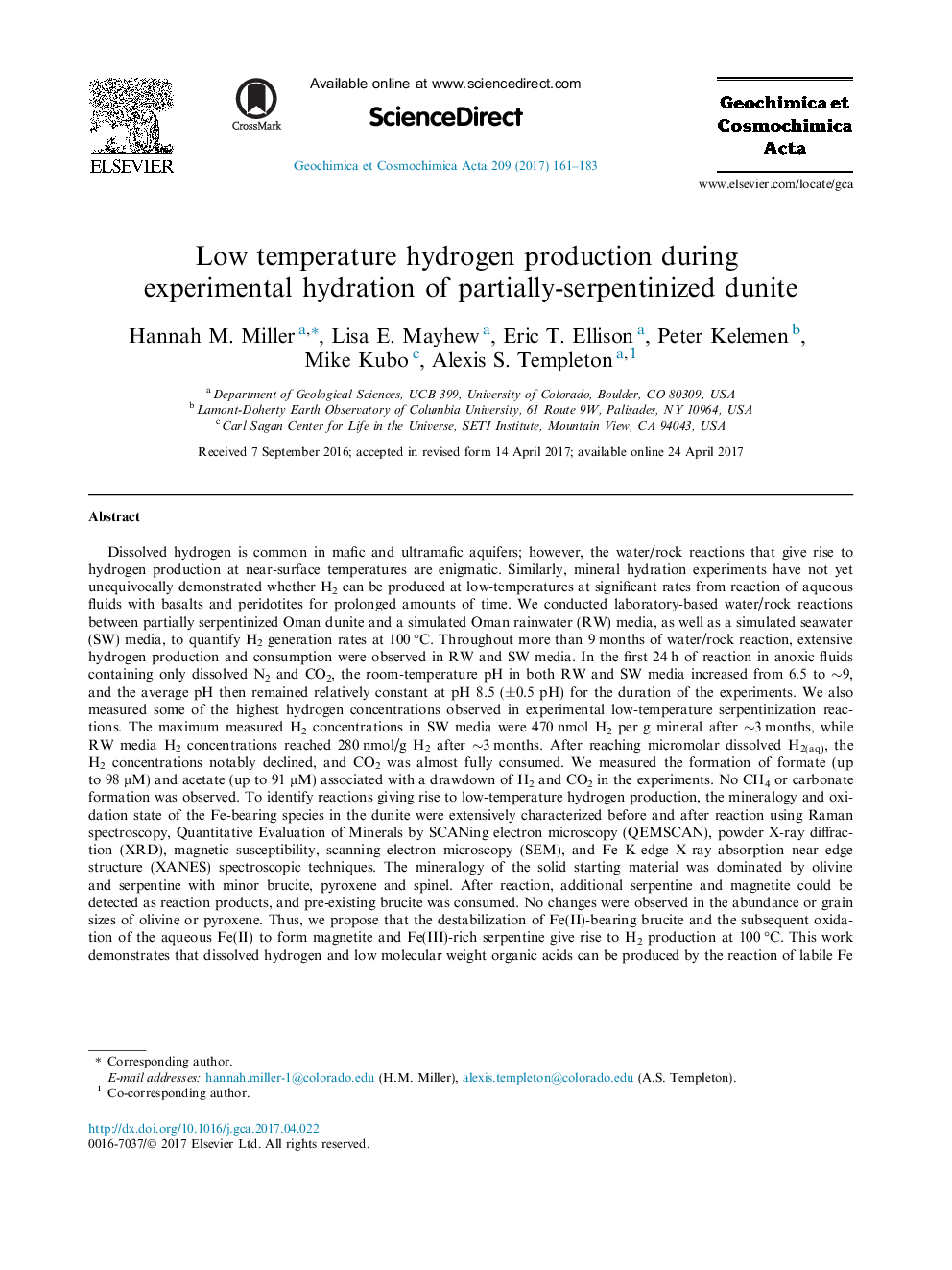| کد مقاله | کد نشریه | سال انتشار | مقاله انگلیسی | نسخه تمام متن |
|---|---|---|---|---|
| 5783283 | 1637948 | 2017 | 23 صفحه PDF | دانلود رایگان |
عنوان انگلیسی مقاله ISI
Low temperature hydrogen production during experimental hydration of partially-serpentinized dunite
ترجمه فارسی عنوان
تولید هیدروژن کم در طی هیدراتاسیون تجربی داونیت نیمه سرپانتینیزه
دانلود مقاله + سفارش ترجمه
دانلود مقاله ISI انگلیسی
رایگان برای ایرانیان
موضوعات مرتبط
مهندسی و علوم پایه
علوم زمین و سیارات
ژئوشیمی و پترولوژی
چکیده انگلیسی
Dissolved hydrogen is common in mafic and ultramafic aquifers; however, the water/rock reactions that give rise to hydrogen production at near-surface temperatures are enigmatic. Similarly, mineral hydration experiments have not yet unequivocally demonstrated whether H2 can be produced at low-temperatures at significant rates from reaction of aqueous fluids with basalts and peridotites for prolonged amounts of time. We conducted laboratory-based water/rock reactions between partially serpentinized Oman dunite and a simulated Oman rainwater (RW) media, as well as a simulated seawater (SW) media, to quantify H2 generation rates at 100 °C. Throughout more than 9 months of water/rock reaction, extensive hydrogen production and consumption were observed in RW and SW media. In the first 24 h of reaction in anoxic fluids containing only dissolved N2 and CO2, the room-temperature pH in both RW and SW media increased from 6.5 to â¼9, and the average pH then remained relatively constant at pH 8.5 (±0.5 pH) for the duration of the experiments. We also measured some of the highest hydrogen concentrations observed in experimental low-temperature serpentinization reactions. The maximum measured H2 concentrations in SW media were 470 nmol H2 per g mineral after â¼3 months, while RW media H2 concentrations reached 280 nmol/g H2 after â¼3 months. After reaching micromolar dissolved H2(aq), the H2 concentrations notably declined, and CO2 was almost fully consumed. We measured the formation of formate (up to 98 μM) and acetate (up to 91 μM) associated with a drawdown of H2 and CO2 in the experiments. No CH4 or carbonate formation was observed. To identify reactions giving rise to low-temperature hydrogen production, the mineralogy and oxidation state of the Fe-bearing species in the dunite were extensively characterized before and after reaction using Raman spectroscopy, Quantitative Evaluation of Minerals by SCANing electron microscopy (QEMSCAN), powder X-ray diffraction (XRD), magnetic susceptibility, scanning electron microscopy (SEM), and Fe K-edge X-ray absorption near edge structure (XANES) spectroscopic techniques. The mineralogy of the solid starting material was dominated by olivine and serpentine with minor brucite, pyroxene and spinel. After reaction, additional serpentine and magnetite could be detected as reaction products, and pre-existing brucite was consumed. No changes were observed in the abundance or grain sizes of olivine or pyroxene. Thus, we propose that the destabilization of Fe(II)-bearing brucite and the subsequent oxidation of the aqueous Fe(II) to form magnetite and Fe(III)-rich serpentine give rise to H2 production at 100 °C. This work demonstrates that dissolved hydrogen and low molecular weight organic acids can be produced by the reaction of labile Fe(II)-bearing minerals generated during a prior stage of water/rock reactions. In particular, progressive alteration of partially-serpentinized peridotites containing brucite may generate sufficient electron donors to fuel in-situ subsurface microbial activity.
ناشر
Database: Elsevier - ScienceDirect (ساینس دایرکت)
Journal: Geochimica et Cosmochimica Acta - Volume 209, 15 July 2017, Pages 161-183
Journal: Geochimica et Cosmochimica Acta - Volume 209, 15 July 2017, Pages 161-183
نویسندگان
Hannah M. Miller, Lisa E. Mayhew, Eric T. Ellison, Peter Kelemen, Mike Kubo, Alexis S. Templeton,
